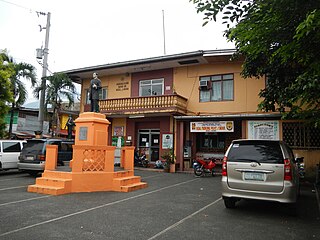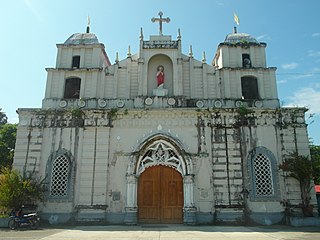
Rizal, officially the Province of Rizal, is a province in the Philippines located in the Calabarzon region in Luzon. Its capital is the city of Antipolo. It is about 16 kilometers (9.9 mi) east of Manila. The province is named after José Rizal, one of the main national heroes of the Philippines. It is bordered by Metro Manila to the west, Bulacan to the north, Quezon to the east and Laguna to the southeast. The province also lies on the northern shores of Laguna de Bay, the largest lake in the country. Rizal is a mountainous province perched on the western slopes of the southern portion of the Sierra Madre mountain range.

Caloocan, officially the City of Caloocan, is a highly urbanized city in Metro Manila, Philippines. According to the 2020 census, it has a population of 1,661,584 people making it the fourth-most populous city in the Philippines.

Teresa, officially the Municipality of Teresa, is a 2nd class municipality in the province of Rizal, Philippines. According to the 2020 census, it has a population of 64,072 people.

Rizal, officially the Municipality of Rizal, is a 5th class municipality in the province of Laguna, Philippines. According to the 2020 census, it has a population of 18,332 people.

Alaminos, officially the Municipality of Alaminos, is a 3rd class municipality in the province of Laguna, Philippines. According to the 2020 census, it has a population of 51,619 people.

Biñan, officially the City of Biñan, is a 1st class component city in the province of Laguna, Philippines. According to the 2020 census, it has a population of 407,437 people.

Tanay, officially the Municipality of Tanay, is a 1st class municipality in the province of Rizal, Philippines. According to the 2020 census, it has a population of 139,420 people.

Altavas, officially the Municipality of Altavas, is a 4th class municipality in the province of Aklan, Philippines. According to the 2020 census, it has a population of 25,639 people.

Balete, officially the Municipality of Balete, is a 4th class municipality in the province of Aklan, Philippines. According to the 2020 census, it has a population of 30,090 people.

Banga, officially the Municipality of Banga, is a 3rd class municipality in the province of Aklan, Philippines. According to the 2020 census, it has a population of 40,318 people.

Lezo, officially the Municipality of Lezo, is a 5th class municipality in the province of Aklan, Philippines. It is the smallest municipality in the province both by population and by land area, and even by revenue. According to the 2020 census, it has a population of 15,639 people.

Makato, officially the Municipality of Makato, is a 4th class municipality in the province of Aklan, Philippines. According to the 2020 census, it has a population of 29,717 people.

Tangalan, officially the Municipality of Tangalan, is a 5th class municipality in the province of Aklan, Philippines. According to the 2020 census, it has a population of 23,704 people.

Diffun, officially the Municipality of Diffun, is a 2nd class municipality in the province of Quirino, Philippines. According to the 2020 census, it has a population of 56,102 people.

Cardona, officially the Municipality of Cardona, is a 3rd class municipality in the province of Rizal, Philippines. According to the 2020 census, it has a population of 50,143 people.

Jalajala, officially the Municipality of Jalajala, is a 4th class municipality in the province of Rizal, Philippines. According to the 2020 census, it has a population of 34,017 people, making it the least populated municipality in the province.

San Jacinto, officially the Municipality of San Jacinto, is a 4th class municipality in the province of Masbate, Philippines. According to the 2020 census, it has a population of 29,686 people.. San Jacinto is the commercial capital of Ticao Island.
The legislative districts of Caloocan are the representations of the highly urbanized city of Caloocan in the various national legislatures of the Philippines. The city is currently represented in the lower house of the Congress of the Philippines through its first, second, and third congressional districts.

The Philippine census is a regularly occurring and official inventory of the human population and housing units in the Philippines. Since 1970, the population has been enumerated every five years. Results from the censuses are used to allocate congressional seats and fund government programs.

The 2020 Census of Population and Housing (CPH) was the fifteenth census in the Philippines and the second census conducted by the Philippine Statistics Authority (PSA).



















